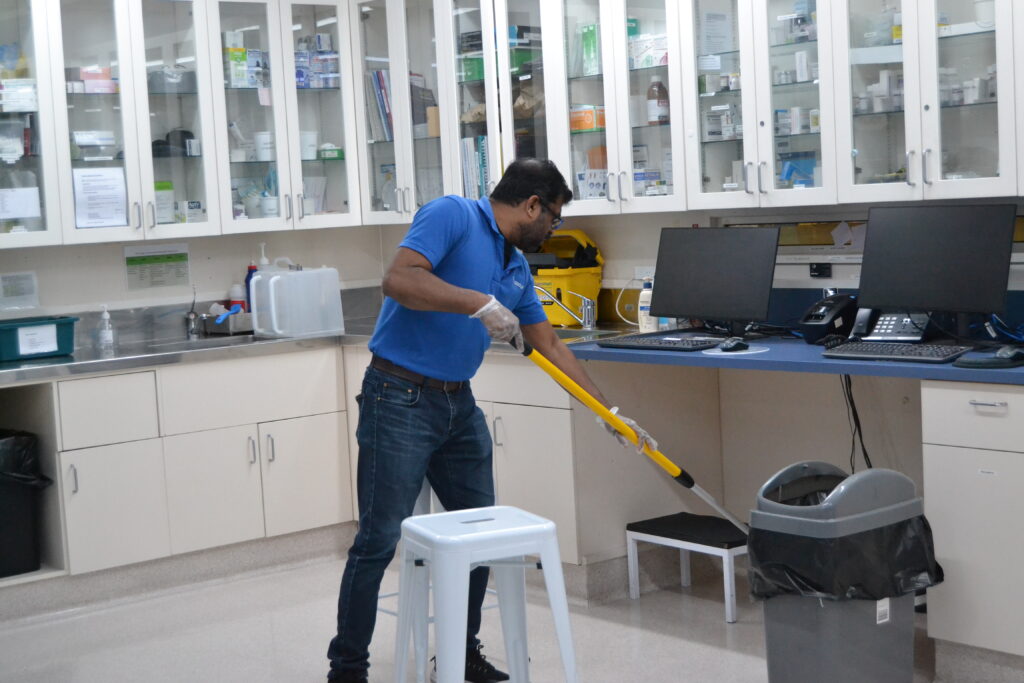These days, whether we scroll through social media, read a newspaper, or flip through a book, we’re constantly coming across terms like cleaning, sanitizing, and disinfecting. They’re everywhere and for good reason. But what do these terms actually mean? Are they the same? Are they connected? And more importantly, how do they affect the way we keep our spaces safe and hygienic?
In this blog, let’s break down these commonly used—but often misunderstood—concepts, and understand why using the right method at the right time is essential for maintaining a healthy environment—whether at home, in the workplace, educational institutions, hospitals, corporate offices, childcare centres, or any other commercial or public space.
So, what exactly do these terms mean?
Disinfection helps break the chain of infection and ensures your environment is safe for everyone.
We also offer High Performance Cleaning—a premium service designed for environments that demand superior hygiene outcomes, deeper sanitation, and long-lasting protection. This solution is ideal for high-traffic or sensitive areas where traditional cleaning just isn’t enough. Whether you need daily cleaning, targeted sanitizing, or post-illness disinfection, QualGroup has you covered—professionally, safely, and efficiently.
Contact us today for your free site audit and take the first step toward a cleaner, healthier space with QualGroup.
-
Cleaning refers to the physical removal of dirt, dust, and debris from surfaces.
-
Sanitizing reduces bacteria to levels deemed safe by public health authorities.
-
Disinfecting takes it a step further by killing germs—including bacteria, viruses, and fungi—on surfaces using chemical agents.
What is Cleaning?
Cleaning involves physically removing visible impurities such as dust, dirt, and crumbs from surfaces. While it doesn’t kill germs, it significantly reduces their presence by eliminating the substances they cling to. Cleaning typically involves the use of cloths, mops, brushes, vacuums, brooms, and basic cleaning agents like soap or detergent. At QualGroup, we prioritise eco-friendly, certified cleaning products and professional-grade equipment to ensure a deep clean with minimal environmental impact. Our trained team handles everything—from desks and carpets to windows and hard floors—with care and precision.How Often Should You Clean Your Office Space?
Maintaining a clean workplace is the foundation of any effective hygiene routine. Here’s a general guideline:-
Daily: Workstations, kitchen areas, restrooms, and high-touch points like door handles, phones, and switches.
-
Weekly: Carpets, upholstery, and inside drawers or cabinets.
-
Monthly: Light fixtures, ceiling fans, and appliances.
-
Quarterly: Exterior windows, under furniture, and deep carpet cleaning.
What is Sanitizing?
Sanitizing focuses on reducing the number of bacteria on surfaces to safe levels, as defined by public health regulations. It’s especially relevant in environments where food is prepared, or where people frequently share equipment or workspaces. Unlike cleaning—which targets visible dirt—sanitizing aims at invisible microbial threats, particularly bacteria.How Often Should You Sanitize Your Office?
-
Daily: Shared surfaces like keyboards, phones, kitchen benches, and light switches.
-
After Each Use: In kitchens or food-handling areas.
-
As Needed: Whenever there’s known exposure to germs or illness in the workplace.
What is Disinfecting?
Disinfecting uses chemical solutions to kill microorganisms, including viruses and fungi, on surfaces. While it doesn’t always remove dirt, it’s a crucial step for eliminating harmful pathogens—especially in high-risk environments such as hospitals, childcare centers, and public restrooms.When Should You Disinfect?
Disinfecting is essential in situations such as:-
After someone has been unwell
-
In bathrooms and toilets
-
In healthcare or medical settings
-
In high-traffic commercial spaces
-
Where bodily fluids are present
Disinfection helps break the chain of infection and ensures your environment is safe for everyone.
Key Differences Between Cleaning, Sanitizing, and Disinfecting
| Feature | Cleaning | Sanitizing | Disinfecting |
|---|---|---|---|
| Purpose | Removes dirt and debris | Reduces bacteria to safe levels | Kills a broad range of germs (bacteria, viruses, fungi) |
| Focus | Visible mess | Bacterial presence | Harmful microorganisms |
| Products Used | Soap, detergent, water, cloths, vacuums | Alcohol-based sanitizers, sprays | Disinfectant sprays, bleach, chemical agents |
| Recommended Frequency | Daily or as needed | Daily (especially in shared areas) | As needed, or after illness/exposure |
| Effectiveness | Lowers risk by removing grime | Kills 99.9% of bacteria | Kills 99.999% of viruses, bacteria, and fungi |
| Time Needed | Immediate action | Minimal contact time | Requires dwell time to be effective |
How Can QualGroup Help?
At QualGroup, we offer professional commercial cleaning services tailored to the unique needs of businesses across New Zealand. With years of experience across office spaces, healthcare facilities, education sectors, and industrial environments, we understand that choosing between cleaning, sanitizing, and disinfecting can sometimes feel overwhelming.
That’s why we provide:
-
A detailed site inspection to assess your specific hygiene needs
-
A customised plan with the right combination of cleaning, sanitizing, and disinfecting
-
Trained professionals using eco-certified products and safe, effective techniques
-
Services that align with New Zealand’s health and safety standards
We also offer High Performance Cleaning—a premium service designed for environments that demand superior hygiene outcomes, deeper sanitation, and long-lasting protection. This solution is ideal for high-traffic or sensitive areas where traditional cleaning just isn’t enough. Whether you need daily cleaning, targeted sanitizing, or post-illness disinfection, QualGroup has you covered—professionally, safely, and efficiently.
Contact us today for your free site audit and take the first step toward a cleaner, healthier space with QualGroup.



